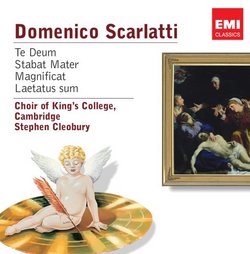| All Artists: Domenico Scarlatti, Stephen Cleobury, Ashley Grote, Daniel Hyde, Nicholas Daly, Timothy Mead, Richard Butler Title: Domenico Scarlatti: Te Deum; Stabat Mater; Magnificat; Laetatus Sum Members Wishing: 0 Total Copies: 0 Label: EMI Classics Original Release Date: 1/1/2009 Re-Release Date: 2/24/2009 Genre: Classical Style: Opera & Classical Vocal Number of Discs: 1 SwapaCD Credits: 1 UPCs: 400000013916, 5099923573628 |
Search - Domenico Scarlatti, Stephen Cleobury, Ashley Grote :: Domenico Scarlatti: Te Deum; Stabat Mater; Magnificat; Laetatus Sum
 | Domenico Scarlatti, Stephen Cleobury, Ashley Grote Domenico Scarlatti: Te Deum; Stabat Mater; Magnificat; Laetatus Sum Genre: Classical
|
Larger Image |
CD Details |
CD ReviewsA voice teacher and early music fan George Peabody | Planet Earth | 05/09/2009 (5 out of 5 stars) "THE QUESTION: IS DOMENICO'S 'STABAT MATER' BETTER THAN HIS PATER'S?
Domenico Scarlatti's (1685-1757) surviving output of sacred compositions is surprisingly small. However, when it comes to the measure of quality, most of his twenty or so church works tower above the ordinary. One piece among them, a setting of the 13th century Franciscan 'Stabat Mater', was greatly admired and widely circulated during the composer's lifetime. Domenico Scarlatti was writing as a renovater of tradition in his impressive 'Srabat Mater' for 10 parts, composed at Rome in 1715, in a contrapuntal style which, on the surface, seems somewhat archaic. In setting to music the processional chant that relived the Passion, Scarlatti was above all paying homage to the city of his birth. Written for four sopranos, two altos, two tenors two basses and organ continuo, this 'Stabat Mater' is strikingly lyrical and mature in manner, and also highly melodic, astonishingly modern and has harmony whose richness and beauty remind one of Mozart's last religious compositions. His haunting 'Miserere', preserved in a Vatican library manuscript, almost certainly touched the hearts of those who attended the legendary service of the Tenebre in the Sistine Chapel during Holy Week. Likewise Scarlatti's only surviving 'Magnificat' setting was probably conceived for use within the Vatican. Scarlatti's 'Te Deum' for eight-part choir, written in Portugal in the 1720's, crowned the local tradition of marking the year's end with a grand service of thanksgiving. The work's vigorous simplicity powerfully projects the famous Latin hymn in praise of God. 'Laetatus sum', a graceful setting of Psalm 121 in the 'modern' style, was no doubt heard for the first time during the marriage service in Janurary 1729 that united the royal houses of Portugal and Spain. The performance of the King's College Choir of each of these compositions is inspiring showing off their vocal attributes to the 'max'. Which means flawless diction, absolutely exquiste sounds, especially from the boys sopranos and the male altos, who happen to be featured in a large part in this music. The boy soprano, Nicholas Daly, is a marvel of vocal skill; his range is wide for his age and his flexibility as he meets the demands of this music is amazing and his tone quality pure and clean as are the rest of the sopranos. Timothy Mead(boy alto) is featured off and on in the 'Laetatus sum', but I did not pick up on him as readily I did the terrific sounding countertenor(unfortunately unnamed) who duets frequently throughout the entire recording with Daly. The interpretations of the various selections as performed by the instrumental ensemble are skillfully handled, and we must give much credit to Stephen Cleobury, who put this all together so beautifully. One other comment: I own the Gardiner 1984 recording of this 'Stabat Mater' and it is equally lovely, the difference being that the sopranos are females. I GUESS YOU, THE LISTENER WILL ULTIMATELY DECIDE 'WHICH 'STABAT MATER' DO YOU PREFER: FATHER OR SON? For myself, I love both; they are just different. I say: VIVE LA DIFFERENCE." |

 Track Listings (18) - Disc #1
Track Listings (18) - Disc #1